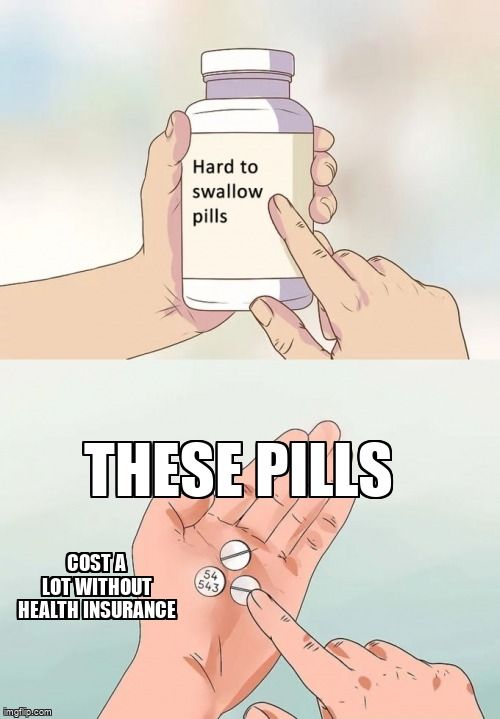
This logo isn't an ad or affiliate link. It's an organization that shares in our mission, and empowered the authors to share their insights in Byte form.
Rumie vets Bytes for compliance with our
Standards.
The organization is responsible for the completeness and reliability of the content.
Learn more
about how Rumie works with partners.
Don't have health insurance? What's the worst that could happen?
Well, it could cost you a fortune if you were to become ill or have an accident that requires hospitalization!

What Are The Choices?
First, you need to determine what your health insurance options are. These may differ based on your employment and your state of residency.
Employer-Sponsored Plan: Employers are required by law to offer insurance to their full-time employees if they employ over 50 people. Premium costs are shared with the employer.
Self-Pay Health Insurance: Market-Place through HealthCare.gov offers insurance for the self-employed, unemployed, or employees whose employer doesn't offer insurance.
Government-Sponsored Plans: Medicaid and Children's Health Insurance are available if you qualify.
No insurance: Holding insurance isn't federally required, but some states do require it.
Did you know?
Insurance Jargon

Deciding on a healthcare plan can be very confusing. Here are some health insurance terms to become familiar with before you start looking at plans.
Premiums: Premiums are the costs you pay for coverage either weekly, monthly or yearly.
Deductible: Deductibles are the costs for healthcare services you are responsible for before your insurance pays.
This cost depends on the plan you choose and can range from $0 to a couple of thousand dollars. Usually, the higher the deductible, the lower the premium and vice versa.
Copays and Coinsurance: Copays and Coinsurances are a method of cost-sharing that insurance plans use to offset some costs.
A copay is the set amount that you pay for a healthcare service, and the plan pays for the rest of the service. Office visits are usually set up as copays.
A coinsurance is a percentage of the cost of a healthcare service you pay.
Non-covered Services: Services such as cosmetic procedures, experimental treatments, genetic testing, weight loss, or over-the-counter products are considered non-covered services
Out-of Pocket: This is the maximum cap you will pay for insurance services (not including premiums) for the year.
If you reach the maximum total with deductibles, copays, and coinsurance, the plan pays at 100% of the costs. That means if you have a lot of healthcare expenses, it will not exceed the amount set by the plan.
In-Network and Out-of-Network: Physician and healthcare facilities are sometimes part of a network.
If you choose a physician in-network, the coverage will be better, but if your physician is out-of-network, you may pay more for services. This is because insurance companies negotiate lower payments for physicians "to be included" in their network.
Quiz
Premiums are included in the out-of-pocket costs.
Premiums are a separate cost from the out of pocket costs.
What Coverage Do I Need?
The coverage you need depends on a lot of factors and the plans offered. Consider the following:
Overall health
If you have a chronic condition, such as asthma or diabetes
If you are involved in risky behaviors, such as skydiving, mountain-climbing, skateboarding, motorcycling
If you are accident-prone
Your budget
If you have a family, or are planning a family
 Photo by Damir Spanic on Unsplash
Photo by Damir Spanic on UnsplashNo one knows for sure what the future holds, so think about possible scenarios such as:
What if I fall and break my leg?
What if I am in a serious accident?
What if I get an illness?
Quiz
You need health insurance even if you eat right, exercise, and are otherwise healthy.
Although you are otherwise healthy, it is wise to have a least some healthcare coverage just in case. You can opt for a lower premium with a high deductible if you think you may not need much coverage and may even save you some money up front, but it is a risk.
How Much?
The cost varies and depends upon what you are willing to pay, what is available to you, and can afford. You need to also consider any health risk factors you may have.
Compare Plans
In this example, you will compare two typical plans offered by an employer as a benefit for a single employee.
Remember, employers share some of the costs associated with a health plan, therefore, these costs are usually lower than obtaining insurance on your own.
Let's assume your primary care physician and healthcare system are in-network.
A
High Deductible/Low Premium
Deductible: $4,000 yearly
Premiums: $25.00 weekly
Copays: (Emergency Room $ 100, Office Visits $15)
Coinsurance: None
Out-of-pocket maximum: $10,000
Features: The plan does not pay any expenses until the deductible is met. Then pays 100% of all costs except copays. Copays do not count toward the deductible.
B
Low Deductible/Higher Premium
Deductible: $500 yearly
Premiums: $60.00 weekly
Copays: (Emergency Room $100, Office Visits $25)
Coinsurance: 10% Hospitalization, Outpatient Surgery
Out-of-pocket maximum: $10,000
Features: Plan does not pay anything until the deductible is met. Once the deductible is met, the enrollee still pays copays and coinsurance. Copays and coinsurance do count toward meeting the deductible.
Scenario 1
You are relatively healthy and young and do not have any chronic medical issues. You see your physician once a year. You haven't had any episodes this year.
While playing baseball, you fall and break your arm. You go to the ER, get X-Rays, and get a cast. You have to see a specialist too.
Under Plan A: You will pay everything including a follow-up visit with a specialist, and still not meet the deductible.
Under Plan B: You still pay but with all the expenses, the deductible will be met and medical expenses later will be mostly covered.
Scenario 2
You have diabetes. This requires daily monitoring, insulin, and frequent visits to see your doctor. You have a history of frequent hospitalizations.
Under Plan A: You will pay all of your medical expenses up to the deductible and if you have to be hospitalized, will meet it. Then, if you have another hospitalization in the year, it will be covered.
Under Plan B: You will likely meet the deductible, but if you are hospitalized, you will pay the 10% coinsurances too (can be costly).
Summary
With Plan A, you are betting that either you won't have any healthcare issues and you will save premium costs, or you expect you will have many episodes.
Plan B is the middle of the road, where you might expect some healthcare needs and want to make sure you are covered but don't expect anything major.
Take Action
When choosing a plan:
This Byte has been authored by
Paula Surdu
Instructional Designer
This Byte has been reviewed by
Lana Do
MD, MPH, BCMAS
